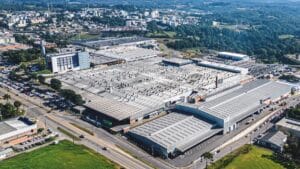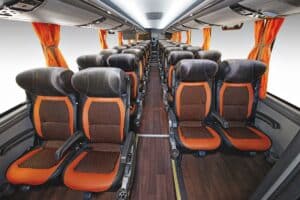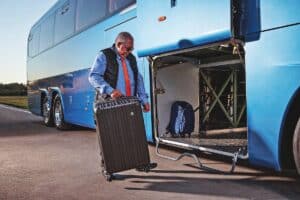For 75 years, Marcopolo has been at the forefront of bus and coach manufacturing, evolving from a small Brazilian operation into a global industry leader.
With 14 production facilities, three in Brazil and 11 overseas, the company produces up to 240 buses a day and has delivered more than 475,000 vehicles across 140 countries.
- Subscribe to our free weekly newsletter to receive the latest news and classifieds from Australasia’s bus and coach industry
- Don’t miss a second and subscribe to our monthly ABC magazine
Marcopolo’s presence in Australia is anchored by its wholly owned subsidiary Volgren, the country’s largest bus manufacturer. Volgren, a 45-year-old company, plays a key role in adapting and supporting Marcopolo products for local operators, ensuring they meet the demands of Australia’s transport networks.
Now, the duo is gearing up to bring one of Marcopolo’s much-loved models to Australian shores – the Marcopolo G8.

The G8 is the latest evolution in the company’s lineup of premium coaches, designed with a focus on efficiency, safety and passenger comfort. Launched in 2021 amid the challenges of the COVID pandemic, the G8 introduced a new level of innovation to long-distance travel, reflecting Marcopolo’s decades of experience in bus manufacturing.
Since its debut, nearly 4,000 G8 units have been delivered worldwide, serving a range of markets with configurations from streamlined two-axle models to four-axle double-decker coaches.
“The Marcopolo G8 is the market leading product in basically every country where Marcopolo operates, which includes South America and now South Africa,” Volgren Australia chief executive officer Thiago Deiro told ABC.
“This is the first time Volgren has been involved in bringing a coach product into Australia from Marcopolo and we had to jump through many hoops to make it a reality.”
As Brazilian regulations differ greatly from those set out in the Australian Design Rule (ADR) requirements, Marcopolo and Volgren have worked closely to “design the coach from scratch” for local customers.
“We completely redesigned the model to ensure it would meet Australian regulations,” Deiro says.
“We also spent a lot of time talking to customers overseas to get feedback that was used to improve the model.”
While the G8 makes an immediate impression with its sleek, aerodynamic design, the internal structures of the model are even more impressive. Every detail is engineered with passengers, drivers and operators in mind.
“The main goal of the new design was to increase performance, lower fuel consumption and operational time while also focusing heavily on driver and passenger comfort,” Volgren chief commercial officer Yuri Tessari told ABC.
“The G8 comes with specific things you wouldn’t see in any other product.”

From enhanced safety features to improved technology and streamlined maintenance, the G8 introduces more than 60 patented innovations to boost comfort, reliability and operational efficiency. The result is a coach that not only looks dynamic but delivers tangible benefits on the road.
“The G8 places significant emphasis on driver comfort and safety, recognising its crucial role in the vehicle’s operation,” Tessari says.
“The cabin’s ergonomics were redesigned, incorporating high-quality finishes such as injected parts for durability and ‘soft touch’ surfaces that reduce internal noise and add a touch of sophistication.”
The driver’s space also features newly designed speakers and fibre-optic indirect lighting, offering customisable light levels without compromising safety. The instrument panel has been revamped to ensure ease of use, with a new control interface that allows the driver to manage bus functions either through a 10-inch head unit or a set of intuitive keys located at the bottom of the panel, ensuring redundancy and seamless operation.
Driver safety and visibility were top of mind when designing the G8, including several key design enhancements. Blind spots have been eliminated, and the dashboard height has been lowered by 70mm to improve road visibility.
The rear-view mirrors have also been redesigned, now featuring a six per cent increase in reflective lens width for a broader field of view. For even greater safety, an optional indirect mirror system uses cameras to replace traditional mirrors, further eliminating blind spots and integrating infrared technology for enhanced night vision.
“We also ensured that passenger comfort was high on our priority list, with an advanced LED lighting system that adjusts in colour and intensity based on the time of day,” Tessari says.
For entertainment, the G8 offers high-definition monitors and a new collective sound system, with high-quality speakers ensuring a premium audio experience. Audio and video controls are easily accessible on the sides, and the system offers four-channel digital sound, all manageable from the driver’s control centre.

The G8 also reimagines the onboard toilet for better passenger comfort and ergonomics. With internal support for added safety and convenience, the toilet features climate control with air conditioning, an automatic closing flat door, UV-C lighting and an Eco flush system for more sustainable operations. For improved efficiency and odor control, the option of a vacuum suction system, similar to those used on airplanes, is available, ensuring a clean and comfortable environment.
“Seven decades of expertise have come together in the G8, a product born from Marcopolo’s relentless pursuit of innovation and reliability,” Tessari says.
“The company has invested more than 7,000 hours in virtual simulation testing and an additional 10,000 hours in physical laboratory and road testing, simulating more than 11,000kms during the G8’s development to ensure long-term durability and performance.”
Going beyond standard simulations, Marcopolo conducted a physical crash test, achieving results 78 per cent better than the requirements set by the ECE R66 regulation from the Vehicle Certification Agency (VCA). Marcopolo also performed the first-ever rollover crash test on a double-decker coach as part of the G8’s validation process, setting a new benchmark in safety standards for the industry.
Coming standard with an exclusive full LED head light system, drivers can now see clearer than ever. The technology enhances visibility, extending up to 3.5 times further than traditional lighting systems.
The G8 also integrates Marcopolo’s Biosafe platform, a set of innovative solutions designed to enhance biosafety in public transport. This includes features such as disinfection systems, UV-C lights and antimicrobial surfaces, all aimed at reducing viral and bacterial contamination, making the G8 safer for passengers and operators.
“Beyond safety and comfort, the G8’s design focuses on reducing total cost of ownership,” Tessari says.
“Its unique aerodynamic shape, tested in wind tunnels, achieved an impressive coefficient of just 0.379, optimising fuel efficiency and reducing operational costs.
“Additionally, maintainability was a key consideration in the G8’s design, ensuring that operators can achieve greater business efficiency and performance, making the G8 not just beautiful, but a highly practical investment.”

The front grill system is designed for quick opening, offering easy access for defroster maintenance, while the tilting wheel rim improves cooling and reduces tire wear.
Volgren, in partnership with Marcopolo, is set to launch the G8 to the Australian market in September 2025.
Available in two and three-axle configurations, the model is specifically designed to meet the unique needs of Australian operators and passengers. This tailored approach ensures compliance with local regulations and suitability for both urban and long-distance travel across Australia’s diverse terrains.
“The introduction of the Marcopolo G8 marks a pivotal moment in the global push to modernise bus fleets, offering superior comfort, safety and efficiency,” Deiro says.
“Its arrival in Australia is poised to set new standards in the coach travel industry, challenging other manufacturers and operators to raise their benchmarks.
“As the G8 begins operations, it is expected to transform passenger expectations and redefine bus travel in the region, marking the start of a new era in the Australian bus industry.”


